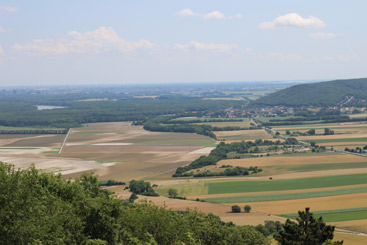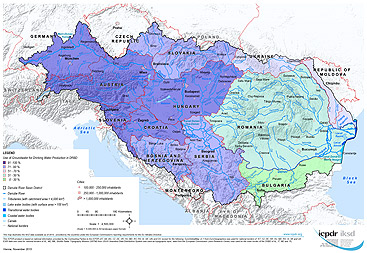Groundwater: the river’s invisible twin

Groundwater: the river’s invisible twin
A vital source of drinking water and water for irrigation, groundwater also feeds rivers all year round. However, because it is hidden away below the surface, groundwater is extremely susceptible to pollutants and over-extraction.

Rivers, wetlands and groundwater are highly interconnected. When river water is high, it infiltrates into the groundwater system, and in dry periods groundwater recharges wetlands and river flows, helping to prevent drought.
© ICPDR
Groundwater is largely invisible; we often ignore it or take it for granted. But the truth is that groundwater has incredibly important values for people, industry and the environment throughout the Danube River Basin. And to maintain those values, it desperately needs our constant protection.
Nearly 72% of all drinking water consumed in the Danube River Basin is produced from groundwater sources, serving an overall population of some 59 million people. Groundwater also provides much-needed water for agricultural irrigation, and it is an important resource for other industrial activities. Applications for cooling and heating also often depend on groundwater sources.
Alongside its multiple benefits for people, it has become increasingly clear that groundwater should be protected for its environmental values. Its essential role in the basin’s hydrological cycle brings numerous environmental goods and services, such as providing livelihood for wildlife species.
Surface water and groundwater tend to be highly interconnected. When the river surface water level is high, river water infiltrates into the groundwater system. This is especially true during high flows, when both the river and adjoining floodplains and meadows can become flooded. In drier periods, groundwater can help recharge wetlands and even river flows, acting as a buffer and thereby helping to prevent drought. This exchange includes quantities of water as well as concentrations of potential pollutants in the water that might be transferred.
Groundwater faces many threats. The main risk to groundwater quality comes from pollution – such as untreated sewage from cities, fertilisers and pesticides from agriculture, or chemicals leaching from contaminated industrial waste sites.
Pollution can reach groundwater reserves in many ways, such as through direct discharge from a point-source to a water body, or indirect discharge through soil infiltration. As a result, some groundwater sources cannot be used without prior treatment. As for groundwater quantity, the main pressure is excessive abstraction by users, such as for drinking water or agriculture.
The international response. Ensuring that groundwater in the Danube River Basin is monitored and protected is an important goal of the Danube River Protection Convention has been one of the main issues managed by the ICPDR and its Groundwater Task Group. All Danube countries, whether they are EU Member States or not, are fully involved, demonstrating the joint interest of all countries in the basin to ensure the protection and proper management of groundwater. Over the years, the ICPDR and Danube countries have successfully identified 11 transboundary groundwater bodies of basin-wide importance. They have also formulated basin-wide visions regarding the pollution of groundwater and its sustainable use.

Use of Groundwater for Drinking Water Production in DRBD
Nearly 72% of all drinking water consumed in the Danube River Basin is produced from groundwater sources, serving
an overall population of some 59 million people.
© ICPDR
Meeting EU water legislation. The Danube countries have been actively taking steps to achieve the objectives of the EU’s Water Framework Directive (WFD) and the more specific Groundwater Directive. The WFD requires Member States to achieve a ‘good status’ for all waters in the EU by 2015. This includes a good status for all Danube basin groundwater bodies – in terms of chemicals (i.e. the water should be clean) and in terms of quantity (i.e. there should be no groundwater overexploitation). Furthermore, achieving good status is not only relevant from the perspective of human uses, but also for the health of aquatic and terrestrial ecosystems that depend on groundwater.
Broadly speaking, the comprehensive WFD aims at preventing deterioration, and enhancing, restoring and protecting Europe’s surface and groundwater bodies through a challenging set of actions. It requires the identification, characterisation and review of the impacts of human activities. To achieve the demanding WFD objectives, a comprehensive programme of measures is essential to address existing and expected groundwater problems.
Overall, transboundary and integrated river basin management is needed, as water does not respect administrative or political boundaries and moves continuously above and below the surface within the hydrological cycle, from one reservoir to another (e.g. from air to rivers, lakes, oceans, wetlands, soil and aquifers). Continuous monitoring and periodic reviews and reporting, including public participation, are required to achieve the overall goals in due time.
In the Danube River Basin Management Plan the ICPDR developed such a programme which will ensure that the water use is appropriately balanced and does not exceed the available groundwater resource, considering future impacts of climate change and that the emissions of polluting substances would not cause any deterioration of groundwater quality.





